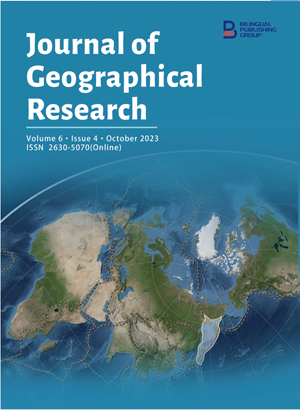-
1409
-
368
-
312
-
224
-
194
Locating Global System for Mobile Communication (GSM) Base Stations Using Geographic Information System (GIS)
DOI:
https://doi.org/10.30564/jgr.v6i4.5857Abstract
The global system for mobile communication (GSM) is planned to meet the needs of the whole subscribers. The number of subscribers increased as the population increased due to the acceptance of GSM services by the subscribers. Thus, there should be a way to monitor base stations that will meet the increasing demand of subscribers in any area as a population surge will lead to more subscriptions. This will allow GSM network operators to serve their subscribers better and ease network congestion. This work presents a review of mobile evolution from the first generation to the fifth generation. A review of global positioning system (GPS) technology and its applications to geographic information systems (GIS) was done. The coordinates of these base stations were taken using a GPS device. These base station coordinates were then exported to QGIS for the design of the map. Thereafter, the output map was then integrated into the website. The discussions on the results followed and some useful suggestions given will go a long way to help the operators of GSM in Nigeria and in general. If the propositions given are adhered to, it will go a long way to help the operators reduce congestion on their network and thereby increase the satisfaction of the subscribers.
Keywords:
Global system for mobile communication (GSM); Global positioning system (GPS); Geographic information system (GIS); Subscriber; MAP; ImagesReferences
[1] Kuboye, B.M., Dada, O.A., Akinwonmi, F.C., 2013. GSM base stations location monitoring using geographic information system. International Journal of Computer Network and Information Security. 5(8), 39.
[2] Janecek, A., Valerio, D., Hummel, K.A., et al., 2015. The cellular network as a sensor: From mobile phone data to real-time road traffic monitoring. IEEE Transactions on Intelligent Transportation Systems. 16(5), 2551-2572.
[3] Carrion, D., Migliaccio, F., Minini, G., et al., 2016. From historical documents to GIS: A spatial database for medieval fiscal data in Southern Italy. Historical Methods: A Journal of Quantitative and Interdisciplinary History. 49(1), 1-10.
[4] Jahankhani, H., Al-Nemrat, A., Hosseinian-Far, A., 2014. Cybercrime classification and characteristics. Cyber crime and cyber terrorism investigator’s handbook. Syngress: Oxford. pp. 149-164.
[5] Ahmed, U., Musa, A., 2016. Assessment of mobile phone use in Nigeria from inception to date. Scholars Bulletin. 2(4), 192-197.
[6] Kumari, K.S., Singh, D.K., 2021. Evolution of mobile communications systems from zero generation to fifth generation: A review. International Journal of Research Publication and Reviews. 2(9), 618-623.
[7] Ali, E., 2020. Global Positioning System (GPS): Definition, Principles, Errors, Applications & DGPS [Internet]. Available from: https://www.researchgate.net/profile/Ershad-Ali-/publication/340514635_Global_Positioning_System_GPS_Definition_Principles_Errors_Applications_DGPS/links/5e8e1191a6fdcca789fe35e1/Global-Positioning-System-GPS-Definition-Principles-Errors-Applications-DGPS.pdf
[8] Lange, A.F., Gilbert, C., 1999. Using GPS for GIS data capture. Geographical Information Systems. 1, 467-476.
[9] Hong, S., Vonderohe, A.P., 2014. Uncertainty and sensitivity assessments of GPS and GIS in tegrated applications for transportation. Sensors. 14(2), 2683-2702.
[10] Zu, E., Shu, M., Huang, J., et al., 2021. Development of a monitoring and management system for nonheritage tourist attractions based on mobile GIS and multisensor technology. Mobile Information Systems. 9130244. DOI: https://doi.org/10.1155/2021/9130244
[11] Kim, J.Y., Eun, S.J., Park, D.K., 2018. Malaria vulnerability map mobile system development using GIS-based decision-making technique. Mobile Information Systems. 8436210. DOI: https://doi.org/10.1155/2018/8436210
[12] Baral, H., 2013. Applications of GIS in community-based forest management in Australia and Nepal) [Master’s thesis]. Parkville: The University of Melbourne.
[13] Zhang, J., 2021. Research on classroom teaching evaluation and instruction system based on GIS mobile terminal. Mobile Information Systems. 9790766. DOI: https://doi.org/10.1155/2021/9790766
[14] Chen, X., Wu, H., Tri, T.M., 2012. Field strength prediction of mobile communication network based on GIS. Geo-Spatial Information Science. 15(3), 199-206.
[15] Nowak, M.M., Dziób, K., Ludwisiak, Ł., et al., 2020. Mobile GIS applications for environmental field surveys: A state of the art. Global Ecology and Conservation. 23, e01089.
[16] Hariani, M.L., Astor, Y., 2021. Determination of the fastest route for fire trucks in cirebon city based on distance, time, congestion and land use. Journal of Green Science and Technology. 5(1).
[17] Das, D., Ojha, A.K., Kramsapi, H., et al., 2019. Road network analysis of Guwahati city using GIS. SN Applied Sciences. 1, 1-11.
[18] Yang, Y., Tang, J., Luo, H., et al., 2015. Hotel location evaluation: A combination of machine learning tools and web GIS. International Journal of Hospitality Management. 47, 14-24.
[19] Ahmed, S., Ibrahim, R.F., Hefny, H.A. (editors), 2017. GIS-based network analysis for the roads network of the Greater Cairo area. Proceedings of 2nd International Conference on Applied Research in Computer Science and Engineering ICAR’17; 2017 Jun 22-23; Baabda, Lebanon.
[20] Amiri, T., Banj Shafiei, A., Erfanian, M., et al., 2023. Using forest fire experts’ opinions and GIS/remote sensing techniques in locating forest fire lookout towers. Applied Geomatics. 15(1), 45-59.
[21] Aouadj, S.A., Degdag, H., Hasaoui, O., et al., 2023. Contribution of GIS and remote sensing for the risk mapping of soil water erosion at Saida Province (Western of Algeria). Advanced Research In Life Sciences. 7(1), 10-21.
[22] Kobayashi, A., 2019. International encyclopedia of human geography (second edition). Elsevier: Amsterdam.
[23] Cutts, A., Graser, A., 2018. Learn QGIS: Your step-by-step guide to the fundamental of QGIS 3.4. Packt Publishing Ltd.: Birmingham.
Downloads
How to Cite
Issue
Article Type
License
Copyright © 2023 Bamidele Moses Kuboye, Victor Gbenga Abiodun

This is an open access article under the Creative Commons Attribution-NonCommercial 4.0 International (CC BY-NC 4.0) License.




 Bamidele Moses Kuboye
Bamidele Moses Kuboye






